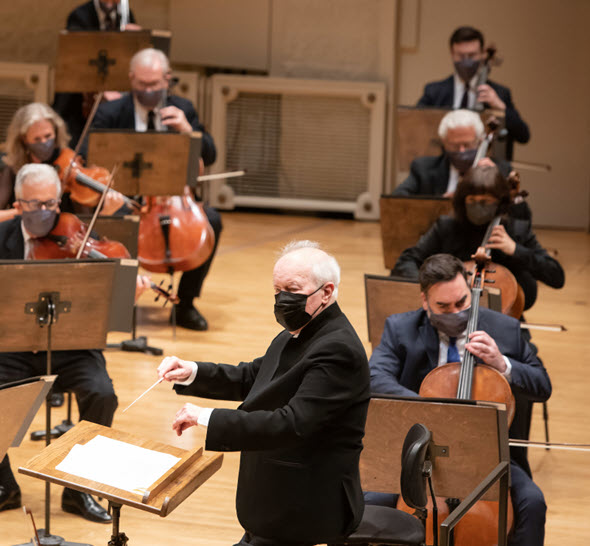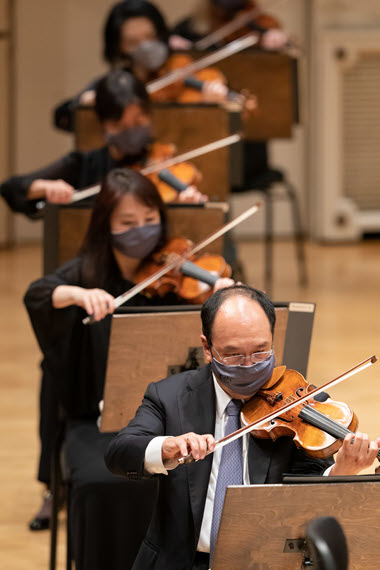De Waart leads dramatic Mozart-Wagner mix capping CSO’s brief pandemic survival season
Review: The Chicago Symphony Orchestra, conducted by Edo de Waart, closes out its mini-season. Program repeats June 12 and 13.
By Lawrence B. Johnson
There was an assured directness, unmannered and unhurried, in conductor Edo de Waart’s excursion through Mozart’s Symphony No. 40 in G minor with the Chicago Symphony Orchestra. The music’s customary darkness gave way to an expansive spirit in a performance that converged issues of tempo and rhythm into their expressive essence simply as pulse.
That almost gemütlich 40th Symphony capped the matinee concert of Mozart and Wagner I heard June 11 at Orchestra Hall, the final program in a three-week CSO mini-season that refused to let the pandemic sweep away all. If it was not the full Chicago Symphony on stage, the masked, socially distanced contingent was at least a healthy representation, and its sound was recognizably vigorous, lustrous and poised.
Likewise pandemic-defiant was the very presence of De Waart, who turned 80 on June 1. Former music director of the San Francisco Symphony, music director-emeritus of the Milwaukee Symphony, De Waart is also a longtime friend of the CSO whose authoritative leadership on this occasion lifted the concert well above the level of make-shift or make-do. For 60 minutes, a scant, socially distanced audience of 398 was reminded of why music and especially this orchestra are so important in their lives. Witness the noisy ovations that seemed to swell beyond the scope of the source.
Even though the City of Chicago officially shed its mask the morning of this performance, the Chicago Symphony opted to keep all pandemic protocols in place through the remaining concerts June 12 and 13. Patrons are assigned arrival times according to their seat locations, and everyone in the building is required to wear a mask – including members of the audience, even while seated. Except for wind players, all the musicians also continue to wear masks. The conductor, too, was masked.
Perhaps because we’ve been looking at each other’s shielded faces for so many months, masks on stage have not been a compromising visual issue. Nor was the scattering of musicians about the stage, which also had been the case for the two previous programs in this brief series. More striking by far was the large and welcome assembly of CSO musicians and the restoration of their disciplined, stylish playing. Mozart’s elegantly shaped and compelling 40th Symphony brought this little season to a grand consummation.
If De Waart’s tempos in the G minor Symphony were comparatively slow from the outset, his clear-sighted and expressive phrasing allowed the music’s inner voices to sparkle and the CSO’s collective virtuosity to display itself. Nothing was tossed away or glossed over in the opening movement’s agitation or in the finale’s welling surge. The slow movement, the one place where De Waart actually pushed the tempo a bit, acquired an uncommon and quite fetching buoyancy. And Mozart’s darkly tinged minuet took on an ear-opening lightness. All told, a highly personalized 40th Symphony possessed of rare charm.
De Waart also opened his program with Mozart, the Overture to “Don Giovanni,” a clever bookend to the 40th Symphony in its shadowy aspect and shifting emotional ground. By devices as seemingly elementary as rising and falling figurations, Mozart evokes, even in this overture, the sexually predatory Giovanni’s obsessive, unstable and threatening character. The CSO framed that ominous portrait with finely contoured string playing, punctuated by winds and brasses that caught the dreadful chill of Giovanni’s soul, so inaccessible to human empathy that he could invite the stone statue of a man he had killed to supper.
As sunny relief at the midpoint of this uninterrupted concert came Wagner’s “Siegfried Idyll,” which the composer wrote as a present for his wife Cosima after the birth of their son Siegfried in 1869. The music, which possesses all the bucolic warmth and heart’s ease that the title suggests, was cast originally for 13 instruments but subsequently orchestrated to nearly three times that size for concert performance. De Waart and the CSO captured the work’s fundamental gentleness as well as its understated sensuality and pervasive radiance – a welcome calm in a global storm still evident amid the precautions on view everywhere at Orchestra Hall.





